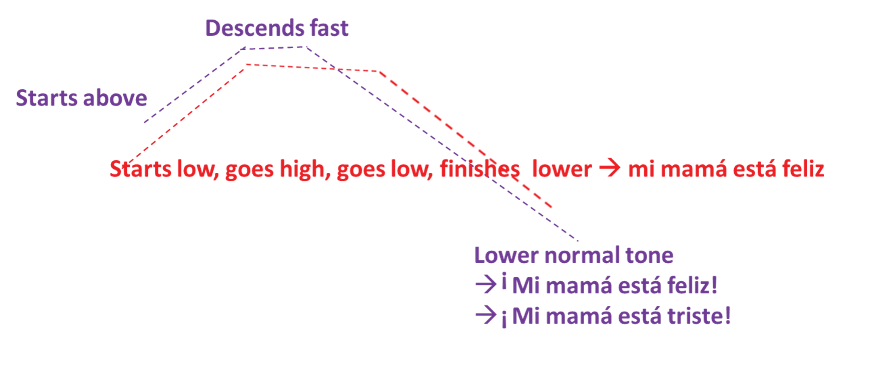Unidad 4: En mi casa
3. Comprendamos la entonación del idioma español
The pattern or melody of rising or falling pitch changes in the voice when used in speaking is known as intonation. This pattern distinguishes kinds of sentences or speakers of different language cultures. Often people say that English intonation has too many variations and Spanish intonation is more constant. Let’s examine the elements that comprise intonation to understand this variation. Intonation is the result of stress and tone.
Stress is when we give particular emphasis or importance to a letter, syllable or word. Here we find the first big difference between Spanish and English. As we studied, Spanish words have a stressed syllable (sílaba tónica). The stress is on the vowel of the stressed syllable. All words have stress. In English, we have a stress on each word, but we also stress the content words in the sentence; content words being nouns, verbs or adjectives.
English stresses certain words: Content words. Let’s see the next example:
- My mother has a new house.
- My mother has a new house

For Spanish all the words are stressed the same: Mi mamá tiene una casa nueva.

In Spanish we don’t differentiate between the content and the function words. That is the reason the intonation seems more consistent in Spanish.
Let’s see the next example:
- ¡Mi mamá está feliz! My mom is happy!
- ¡Mi mamá está triste! My mom is sad!
Tone, in general terms and to avoid confusion, is the musical sound when we speak that has different degrees from high to low. As in English, Spanish intonation depends directly on the type of sentence that we are saying. We have three types of sentences and each one of them has a specific tone pattern.
Declarative/declarativas are used in making a statement. Spanish intonation starts in a low tone, rises to a higher one on the first stressed syllable, maintains the tone until the last stressed syllable, and then goes back to the initial low pitch, dropping even lower at the very end. Mi mamá está feliz = My mother is happy.
 At this time, our objective is that you understand the difference in the tones. With practice it will become natural to you, as your native language tone. Keep in mind, declarative sentences in Spanish:
At this time, our objective is that you understand the difference in the tones. With practice it will become natural to you, as your native language tone. Keep in mind, declarative sentences in Spanish:

Exclamatory/exclamativas are used in making a statement expressing excitement or emotion. When we write an exclamatory sentence we use the exclamation marks to represent the excitement or emotion. When we are speaking, it is the difference of the tone that tells us the excitement or the emotion that we are feeling. In English, we only use one exclamation mark at the end of the sentence, but in Spanish remember we open and we close the exclamation with exclamation marks at the beginning and end of the sentence. When we speak in Spanish, we follow the same pattern as the declarative sentences, but we start above the normal tone and quickly descend into below the normal pitch.
In red, we have the pattern of a declarative sentence: Mi mamá está feliz. In purple, we have the pattern in an exclamative sentence: ¡Mi mamá está feliz! Although they are the same words in English and Spanish, the difference is in the tone when we speak and in the exclamation marks when we write.

Interrogative/interrogativas are used to make questions. In Spanish, the interrogative sentences are declarative sentences with questions marks (opened and closed). In Spanish, you may change the structure like in English:
- ¿Mi mamá está feliz? My mother is happy?
- ¿Está feliz mi mamá? Is my mother happy?
The two options are correct!
That it is the reason why it is so important that you understand the change of tone when you ask a question when speaking. The only difference between a declarative and interrogative sentence is the tone when you are speaking or the opened and closed questions mark, when you are writing.
Oraciones declarativas:
- Tú estudias español.
- You study Spanish.
¿Oraciones interrogativas?
- ¿Tú estudias español?
- Do you study Spanish?
The tone pattern in Spanish interrogative sentences starts as in the exclamatory sentences, above the normal tone. From here the following syllables are descending until the last syllable where the tone rises again. In green you can see how the tone pattern is in an interrogative sentence.
We have interrogative sentences that start with an interrogative word; these are never confused with the statements and follow almost the same pattern that we use in English interrogative sentences. The interrogative word in Spanish, as you remember always is stressed.
The last interrogative questions that we will study, are the tag questions. This is used when the person knows the answer or is trying to direct it. Your mom is happy, isn’t she?
These are very simple because they are declarative sentences, followed by a word that implies the question. In Spanish frequently we use ¿verdad? right ? ¿no? not (literally)? In other words, we use the intonation for declarative sentences and we use the intonation for the interrogative sentences only in the short tag: ¿verdad? right ? ¿no? not?
Observa el video 1.4.3 to be able to answer the following questions that we are going to discuss in class. Remember use all the words in Spanish that you can in your answers. (Diglot Weave Method)

- The meaning of a sentence depends on what factor(s)? _____________________________________
- What types of intonation do we have in English? ___________________________
- What are the differences between Spanish and English intonation: ____________________________________________
For now, you have some idea about intonation, stress and tone in the different sentences. With practice, you will see and hear the difference. If you are curious about other accents or to listen to Spanish dialogues to practice, you can visit the web site developed by “Unversitat Pompeu Fabra Barcelona, España.”
Observa el website 1.4.4 Atlas interactivo de la entonación del español and start practicing.

